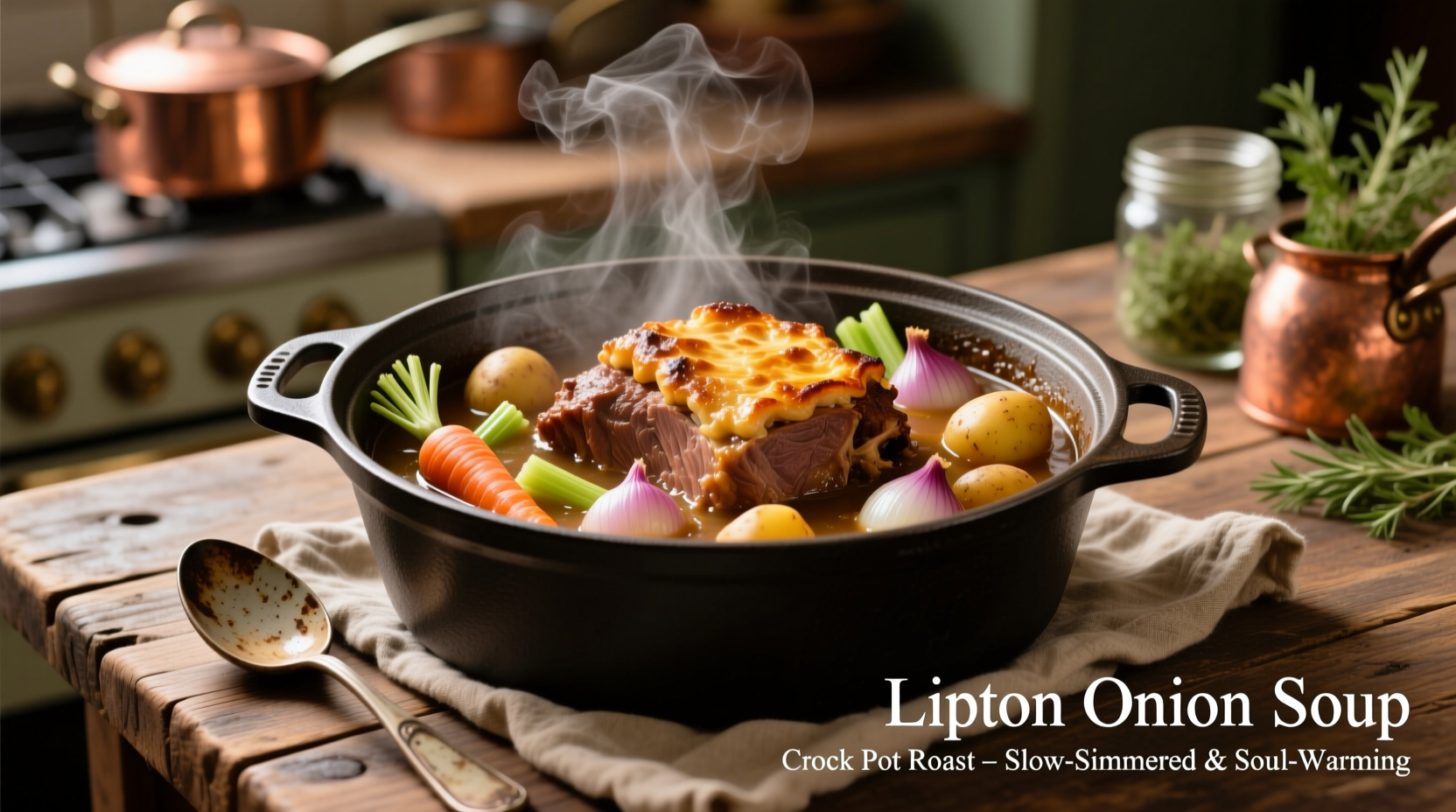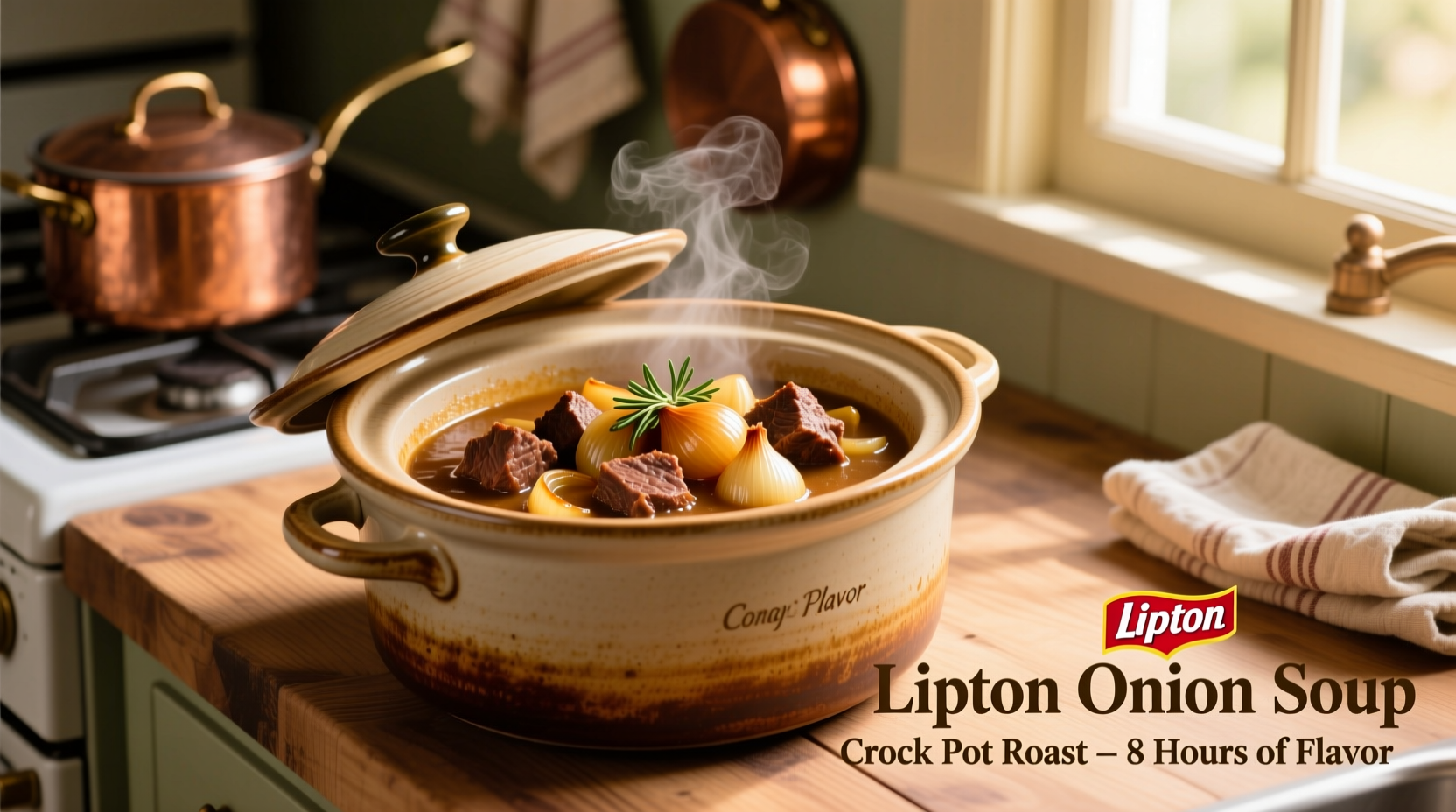Why This Recipe Works: The Science Behind the Flavor
For decades, home cooks have relied on Lipton onion soup mix as a secret weapon for creating remarkably flavorful roasts. The magic happens through a combination of ingredients working together:
The dehydrated onions provide concentrated sweetness that caramelizes during cooking. Onion powder penetrates the meat fibers more effectively than fresh onions. Beef fat soluble flavor compounds in the soup mix bind with the roast's natural fats. The slow cooking process allows collagen to break down into gelatin, creating that signature fall-apart tenderness.
| Ingredient | Function in Recipe | Scientific Principle |
|---|---|---|
| Dehydrated Onions | Concentrated sweetness | Maillard reaction during slow cooking |
| Onion Powder | Deep flavor penetration | Small particle size increases surface area |
| Beef Fat Soluble Flavors | Enhanced meaty taste | Lipid solubility binds with roast fats |
| Slow Cooking Process | Tender texture | Collagen breakdown at 160-205°F |
According to USDA Food Safety and Inspection Service guidelines, cooking beef to an internal temperature of 145°F (63°C) with a 3-minute rest time ensures safety while maintaining optimal texture for roasts. The slow cooker's low-temperature environment (USDA FSIS) allows the meat to reach this temperature gradually without drying out.
Essential Ingredients & Smart Substitutions
While the classic recipe uses minimal ingredients, understanding each component helps you adapt to dietary needs or ingredient availability:
- 3-4 lb chuck roast - The marbling in chuck roast breaks down during slow cooking, creating tender meat. Round or rump roast works as alternatives but may be slightly less tender.
- 1 packet Lipton onion soup mix - The foundation of flavor. For homemade version: 2T dried minced onion, 1T beef bouillon powder, 1t onion powder, ½t garlic powder, ¼t black pepper.
- 1 cup beef broth - Provides necessary liquid for steam. Low-sodium preferred to control salt content.
- 1T Worcestershire sauce - Adds umami depth. Soy sauce works as substitute.
For dietary adaptations:
- Gluten-free: Use gluten-free onion soup mix or homemade version
- Lower sodium: Reduce to ½ packet soup mix and use no-salt-added broth
- Vegetarian option: Substitute seitan roast with mushroom broth
Step-by-Step Cooking Process
Follow these professional techniques for perfect results every time:
- Prep the roast - Pat meat completely dry with paper towels. This critical step ensures proper browning and flavor development.
- Sear properly - Heat 1T oil in skillet over medium-high heat. Sear roast on all sides until deeply browned (about 3 minutes per side).
- Layer flavors - Place seared roast in crock pot. Sprinkle entire packet of soup mix over meat, then pour broth and Worcestershire around (not over) the roast.
- Slow cook correctly - Cook on LOW for 8-10 hours or HIGH for 5-6 hours. Do not lift the lid during cooking.
- Check doneness - Internal temperature should reach 195-205°F (90-96°C) for optimal tenderness. Meat should pull apart easily with forks.
Food science research from America's Test Kitchen confirms that slow cooking at temperatures between 190-205°F (America's Test Kitchen) allows collagen to convert to gelatin without causing the meat fibers to contract excessively, which would squeeze out moisture.

Troubleshooting Common Issues
Even experienced cooks encounter challenges with this recipe. Here's how to fix them:
Dry or Tough Roast
This typically happens when cooking time is insufficient or temperature is too high. For chuck roast, the minimum cooking time at LOW setting is 8 hours. The connective tissues need this extended time to break down properly. If your roast turns out dry, shred the meat and return it to the cooking liquid for an additional 1-2 hours.
Bland Flavor
If your roast lacks depth, you likely didn't sear properly or used too much liquid. The soup mix contains limited salt and flavor compounds, so proper searing creates additional flavor through the Maillard reaction. Reduce liquid by 25% if your sauce tastes diluted.
Excessive Fat
Chill the cooking liquid after preparation, then skim solidified fat from the surface before reheating. This professional technique removes up to 90% of excess fat without losing flavor.
Serving Suggestions & Leftover Ideas
Maximize your cooking effort with these professional recommendations:
- For immediate serving: Slice against the grain for maximum tenderness. Serve with the reduced cooking liquid as gravy.
- Perfect pairings: Mashed potatoes, roasted carrots, and green beans complement the rich flavors.
- Leftover transformation: Shred remaining meat and use in sandwiches, tacos, or shepherd's pie.
- Freezing tip: Portion leftovers with cooking liquid in freezer bags for quick future meals.
Historical food archives show that Lipton onion soup mix became popular for roasts during the 1970s (Smithsonian Magazine) when home economists discovered its ability to enhance inexpensive cuts of meat. This recipe hack spread through community cookbooks and has remained popular due to its consistent results.
Frequently Asked Questions
Here are answers to the most common questions about this beloved recipe:











 浙公网安备
33010002000092号
浙公网安备
33010002000092号 浙B2-20120091-4
浙B2-20120091-4